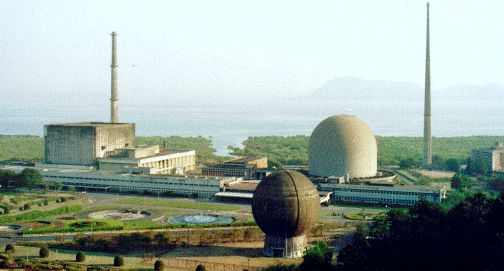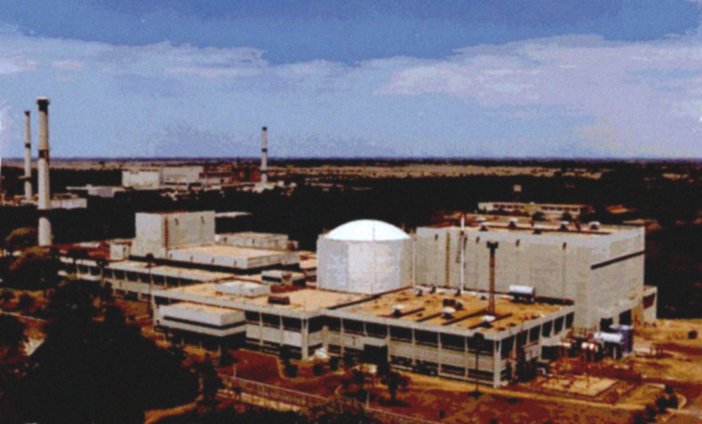bushwhacked? – india’s nuclear programme
It is true that India now suffers and will in future face a huge energy gap.
But it is NOT TRUE that India does not have the resources
to meet our evergrowing energy requirement.
We not only have enough resources for solar and wind generated power stations,
we also have nuclear.
We are the world’s third largest reserve of Thorium.
We have it in abundance in the coastal sands of Orissa and Kerala.
It is believed we have 290 000 tonnes of economically extractable Thorium.
Thorium
Perspectives of the Thorium Fuel Cycle
Why Thorium?
Thorium is much more abundant in nature than uranium.
U-233 bred from thorium is the best of the 3 nuclear fuels, U-235, Pu-239, U-233
It is more eco friendly producing less of long-lived radioactive waste.
Thorium and its compounds are very stable. Its oxide melts around 3300°C.
This stability allows high burn-ups and high temperatures; less chances of accidents.
Why not Thorium?
Thorium needs a “match” to kickstart, that can only be U-235 or plutonium.
[It is an advantage as is an excellent way to use up the excess plutonium stocks]
Reprocessing is an integral part of a sustainable thorium fuel cycle.
Presence of hard gamma emitters makes the manufacture U-233 based fuels in remote gamma-shielded environment mandatory, a very expensive technique.
With our huge Thorium reserves, our scientists haven’t been just sitting around,
they have made utilisation of thorium for large-scale energy production our major goal.
THE THREE-STAGE INDIAN NUCLEAR POWER PROGRAMME
Quoted from Department of Atomic Energy, Government of India document:
“Shaping the Third Stage of Indian Nuclear Power Programme”

The importance of nuclear energy, as a sustainable energy resource for our country, was recognised at the very inception of our atomic energy programme more than four decades ago. A three-stage nuclear power programme, based on a closed nuclear fuel cycle, was then chalked out.
The three stages are:
1. Natural uranium fuelled Pressurised Heavy Water Reactors (PHWRs),
2. Fast Breeder Reactors (FBRs) utilising plutonium based fuel, and,
3. Advanced nuclear power systems for utilisation of thorium.
For carrying out an efficient production of plutonium, the fissile material needed to fuel further growth in nuclear power capacity, a natural uranium fuelled heavy water moderated reactor is the best option.
In the First Stage: we started the indigenous development of nuclear power plants based on uranium cycle in PHWRs. At present we have twelve such reactors under operation, four are under construction, and several others have been planned. We have become self sufficient in all aspects of the PHWR technology. The capacity factors of our operating PHWRs have been close to eighty percent during recent years, an excellent performance even with respect to international standards.
As a part of the Second Stage, we started the FBR programme with the Fast Breeder Test Reactor (FBTR), at IGCAR, Kalpakkam. This reactor, operating with indigenously developed mixed (U+Pu) carbide fuel, has already yielded a large volume of operating experience and a better understanding of the technologies involved. This has enabled us to design 500 MWe (prototype) FBR that will utilise plutonium and the depleted uranium from our PHWRs. Construction of this reactor is due to begin soon.
In preparation for the Third Stage, development of technologies pertaining to utilisation of thorium have been a part of our ongoing activities. Considerable thorium irradiation experience has been acquired in research reactors and we have introduced thorium in PHWRs in a limited way. With our sustained efforts over the past many years, we already have small-scale experience over the entire thorium fuel cycle.
An example is the KAMINI reactor, in IGCAR, the only currently operating reactor in the world, which uses 233U as fuel. This fuel was bred, processed and fabricated indigenously. Efforts are currently on to enlarge that experience to a bigger scale. We are now designing and developing advanced nuclear systems, which will utilise our precious plutonium resources in an optimum way to maximise conversion of thorium to 233U, extract power in-situ from the thorium fuel, and recycle the bred 233U in future reactors.
In India, both Kakrapar-1 and -2 units are loaded with 500 kg of thorium fuel in order to improve their operation when newly-started. Kakrapar-1 was the first reactor in the world to use thorium, rather than depleted uranium, to achieve power flattening across the reactor core.
In 1995, Kakrapar-1 achieved about 300 days of full power operation and Kakrapar-2 about 100 days utilising thorium fuel. The use of thorium-based fuel is planned in Kaiga-1 and -2 and Rajasthan-3 and -4 (Rawatbhata) reactors.
A paper was submitted by Bhabha Atomic Research Centre (BARC) to the International Conference on Emerging Nuclear Energy Systems (ICENES) held June 9-14 in Istanbul this year.
The BARC scientist have claimed that once the world’s uranium runs out, thorium – and the depleted uranium discharged by today’s power reactors – could form the ‘fertile base’ for nuclear power generation. And they are in the process of developing a Fast Thorium Breeder Reactor (FTBR) at the BARC in Mumbai.
They believe their FTBR is a ‘candidate’ reactor that can produce energy from these two fertile materials with some help from fissile plutonium as a ‘seed’ to start the fire. By using a mix of ‘seed’ plutonium and fertile zones inside the core, the scientists show theoretically that their design can breed not one but two nuclear fuels – U-233 from thorium and plutonium from depleted uranium – within the same reactor.
This totally new concept of fertile-to-fissile conversion has prompted them to call it the Fast ‘Twin’ Breeder Reactor. Their calculations show the sodium-cooled FTBR, while consuming 10.96 tonnes of plutonium to generate 1,000 MW of power, breeds 11.44 tonnes of plutonium and 0.88 tonnes of U-233 in a cycle length of two years.
BARC’s FTBR is claimed to be the first design that truly exploits the concept of ‘breeding’ in a reactor that uses thorium. The handful of fast breeder reactors (FBRs) in the world today – including the one India is building in Kalpakkam near Chennai – use plutonium as fuel. These breeders have to wait until enough plutonium is accumulated through reprocessing of spent fuel discharged by thermal power reactors that run on uranium.
The BARC scientists say that thorium should be inducted into power reactors when the uranium is still available, rather than after it is exhausted. The FTBR only needs an initial inventory of plutonium to kick-start the thorium cycle and eventually to generate electricity.
A blanket ban on India re-processing imported uranium – a condition for nuclear cooperation with the US – could make India’s thorium programme a non-starter.
Former BARC director P.K. Iyengar has one suggestion that he says must be acceptable to the US if it is serious about helping India to solve its energy problem. ‘The US and Russia have piles of plutonium from dismantled nuclear weapons,’ Iyengar said, adding: ‘They should allow us to borrow this plutonium needed to start our breeders.We can return the material after we breed enough.’
The Hyde Act and the 123 Agreement with its strict restriction on reprocessing the purchased fuel binds us in a deal to be a purchaser of Uranium and its processing technology.
Instead of breaking free from the NSG cartel, we become chained to it for 40 years.
We have are own N-fuel, we do not need Uranium, we need enriched Plutonium to finish our three stage Nuclear Programme and be energy independant for ever.
This Indo-US nuclear deal will KILL off OUR 50 YEARS of reasearch and hard work.
It is not us who will suffer, we will be dead and gone, it will be our future generations. It is now time for all us Indians to ask questions, and to find the truth for ourselves.
![]() America
America![]() India
India![]() Hyde’s Act
Hyde’s Act![]() 123 Agreement
123 Agreement![]() Thorium
Thorium





pinky said this on August 30th, 2007 at 09:02
Awmyth,
The best thing about your blog is the deep and through research that you do before putting up the facts before us.I had merely any knowledge about the nulear powers of india and to me N-Deal seemed to be a good way ahead for india.But after reading your findings(in this and previous ones related to nuclear deal) on the pros and cons of N-deal, I feel its high time and we indians need to stand and speak out otherwise govt’s decision might turn upsidedown for india.When your research looks to be so important before taking any decision then i can imagine how much important it is to condsider the 50 yrs of research of the scientists.
little indian said this on August 30th, 2007 at 09:51
Thanks Pinki, your feedback makes it worth.
I had commented on three blogs, my views were ridiculed.
Good thing about blogs is I can finish what I want to say.
Usually debates gets sidetracked with arguments.
Reading the Govt of India document made me realise why the scientists themselves are unhappy.
US never gives anything out of goodwill. They know once we have our Thorium reactors functioning, we can thumb our nose at the NSG cartel, be energy independant. When our growth is accelerating, we will become a powerful nation.
Were are about to be truly independant. So now they want to PUT US BACK IN CHAINS. We do not need the US.
Since 1974, US had withdrawn from the previous deal of 1963 citing their Atomic Energy Act, our scientist have had to make do with indegenous technology. Now they see the US twist the same legislation to tempt India to join them in their selfish motives. IRAN.
And this government, for reasons unknown is prepared to sacrifice ALL their hard work.